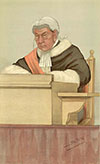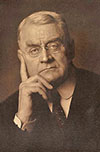The History of the Commercial Court
The Commercial Court was set up in 1895 following demands from the City of London and the business community for a tribunal or court manned by judges with knowledge and experience of commercial disputes which could determine such disputes expeditiously.
The origins of the Court
Lord Mansfield (1705-1793), one the great Judges of the eighteenth century, who served successively as Solicitor General, Attorney General and Lord Chief Justice, originated many of the principles underpinning Commercial Law today. He tried cases at The Guildhall, using special juries to inform him on mercantile customs. The result of his efforts was the growth of commercial litigation in the King’s Bench and a flow of judicial decisions developing the law of contract and other commercial matters. He even took early steps towards a law of restitution – which would later come to be developed by Lord Goff. Lord Mansfield has often been called the founder of English commercial law He modernised practice, introducing fairer and more efficient procedures and shocked his colleagues by often pronouncing judgments orally at the hearing, rather than delaying for months.
Lord Mansfield was also the first English judge to hold that that slavery had no basis in the English common law: in Somersett’s case (PDF) he held that:
“The state of slavery is of such a nature that it is incapable of being introduced on any reasons, moral or political, but only by positive law, which preserves its force long after the reasons, occasions, and time itself from whence it was created, is erased from memory. It is so odious, that nothing can be suffered to support it, but positive law. Whatever inconveniences, therefore, may follow from the decision, I cannot say this case is allowed or approved by the law of England…”
The work done by Lord Mansfield was lost to a large extent after his death and delays became commonplace, increasing with the passing of the Judicature Act of 1873. By unifying and reforming procedure, the Acts gave rise to a large amount of satellite litigation on such points. The Common Law Procedure Act of 1854 had further imported Chancery procedures into the common law courts, such as disclosure by affidavit, and the Chancery practice of “ordinary-language” pleadings which complicated matters further still.
There were also problems with complex commercial matters being heard by judges with no expertise. The classic example was the case of Rose v The Bank of Australasia ariring out of the grounding of the vessel Sir Walter Raleigh. This case is often said to be the spark which led to the foundation of the Commercial Court because Mr Justice Lawrance (“Long Lawrance”), the tallest judge of the King’s Bench Division, but far from the most intellectually gifted, made such a mess of the trial of this case that, it “led the commercial community and Bench to the conclusion that something… must be done”. That was the story as Scrutton LJ liked to tell it, but in reality calls for a commercial court had been made – including by a joint committee of the Bar and the Law Society – from well before the Sir Walter Raleigh’s unfortunate accident.
The idea of a specialist Commercial Court was anathema to the then Lord Chief Justice, Lord Coleridge, He recognised that Parliament’s reforms of the court structure had created a mess, referring to “the enormous expense and endless delay which often attends proceedings at these Courts of law”. But he presided over a period of drift, which saw droves of commercial litigants forsake the courts in favour of arbitration. He actively opposed the initiatives by the Bar and the Law Society in 1888 and in 1892 to found a commercial court with a specialist judge.
The creation of the Court

It was not until Lord Coleridge died and was replaced as Lord Chief Justice by Lord Russell in 1894 that the Commercial List came into being. Lord Russell, himself a former commercial practitioner, was a strong supporter of the creation of a specialist list. With his support, the Queen’s Bench (now King’s Bench) judges found a way to bring the Court into being – the “Notice as to Commercial Cases”.
It was the Council of Judges’ unanimous recommendation that the first Commercial Judge should be J.C. Mathew (pictured right). He originally heard all commercial cases (with two reserve judges in case of illness or absence on circuit). As the work of the Court has expanded, approximately eight judges sit in the Court at any one time at present, drawn from a complement of up to 15 specialist judges authorised to sit in the Court.
From the outset the Commercial Court has been in the vanguard of introducing flexible procedures to deal with the disputes before it as effectively as possible.
The Notice, for example, included the following:
“With respect to town commercial causes it is considered desirable, with a view to dispatch and the saving of expense, that all applications shall be made direct to the Judge charged with commercial business….”
This was the start of the practice, which continues to this day, of all interlocutory applications being made to the Commercial Court judge rather than to Masters. Within the Queen’s Bench (now King’s Bench Division) and Chancery Divisions, this was a feature unique to the Commercial Court, until it was adopted by the recently created Financial List.
The Court was also the originator of what is now known as the Case Management Conference which derived from JC Mathew’s practice of hearing summonses for directions on a Friday, setting down a procedure to trial and fixing a trial date. From the outset it also promoted the desirability of flexible procedure adapted to meet the requirements of the particular case before the court.
The Court’s judges and history

Two of the most illustrious names in the early 20th century were John Hamilton, later Lord Sumner (pictured left), and Thomas Scrutton. These two men were almost exact contemporaries, being of a similar age, and between them came to dominate the Commercial Bar. Having appeared as junior counsel opposite one another in the appeal of the Rose v Bank of Australasia debacle, after they were both appointed as KC in 1901, they became the pre-eminent advocates at the Commercial Bar. Hamilton appointed to the King’s Bench in 1909 and Scrutton in 1910. Hamilton’s subsequent rise proved to be spectacular. He was appointed to the Court of Appeal in 1912, and after a year he was appointed to the House of Lords as Lord Sumner in 1913. In Lord Sumner’s long career in the House of Lords, he sat on almost 300 appeals and over 200 Privy Council cases. Lord Justice Scrutton was appointed a Lord Justice of Appeal in 1916. He also wrote his famous book on charterparties and bills of lading, which is now in its 24th edition, Lord Justice Scrutton built a reputation as one of the foremost commercial judges.
Over the years a great many of our most distinguished judges have served on the bench of the Commercial Court. James Atkin, once Scrutton’s pupil, was appointed to the King’s Bench in 1913 was elevated to the House of Lords in 1928 – where he revolutionised the law of tort in Donoghue v Stevenson.
Other illustrious names well-known to modern lawyers need little elaboration, such as Lord Devlin, Lord Diplock, Lord Goff, Lord Mustill, Lord Bingham, the last senior law lord, and Lord Phillips, the first President of the Supreme Court. Seven of its former judges have been Master of the Rolls: Lord (Richard Henn) Collins; Lord Sterndale (Pickford J); Lord Wright; Lord Donaldson; Lord Bingham; Lord Phillips; and Lord Clarke. Five of its former judges have been Lord Chief Justice: Lord Russell; Lord Goddard; Lord Bingham; Lord Phillips; and Lord Thomas.
In its early years much of the work was based in the worlds of shipping and international trade. Until the 1950s this work was capable of being heard by a single judge. Since then much has changed. Since 1970 the Court was established as a separate court by the Administration of Justice Act 1970 and joined with the Admiralty Court (which was formerly part of the Probate Divorce and Admiralty Division).
The 1970s also saw an extension of the Court’s habitual work, with aviation and financial disputes becoming more common, and with the Court establishing the Mareva (freezing injunction) jurisdiction. The 1980s brought a wealth of insurance and reinsurance disputes – first the cases arising out of the reinsurance spiral triggered by Piper Alpha, and Hurricanes Hugo and Alicia, and subsequently the Lloyd’s Names litigation. Throughout the period an increasing amount of banking and financial markets work joined the more traditional business of the Court.
The modern, international, Court
Since the early 1990s over 75% of the cases issued in the Court have involved at least one foreign party.
Although long trials are infrequent, the trend has been for the length of commercial trials generally to expand in terms of length. When JC Mathew first sat as a judge of the Court, most trials were completed in a day. The current average length of a Commercial Court trial is 9 days and in 2021 the Court heard 11 cases which lasted over four weeks.
The sums in issue, especially in financial cases, can run into billions of pounds. Many cases are of importance to markets and set the standard for industry practice worldwide. Technology – both as an aid to efficient litigation, and as a subject matter – plays an increasingly important part in the Court’s work and administration of justice.
